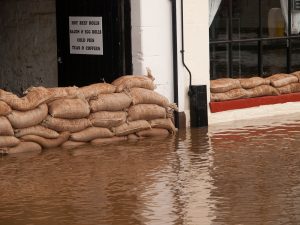Flood barriers are essential tools for managing floodwaters and protecting structures. Here’s a comprehensive guide on how to effectively use various types of flood barriers:
Types of Flood Barriers
Sandbags
Description: Traditional barriers made from burlap or polypropylene filled with sand. They provide weight and stability and are flexible for various terrains.
Vorteile:
- Cost-effective
- Flexible
- Easy to stack
- Suitable for temporary protection of buildings and infrastructure
Benachteiligungen:
- Requires manual filling and significant labor
- Does not create a completely water-tight seal
Inflatable Flood Barriers
Description: Made from durable rubber or synthetic materials, these barriers use air to create a protective wall.
Vorteile:
- Lightweight
- Compact
- Easy to deploy quickly
- Ideal for emergency situations
Benachteiligungen:
- More expensive
- Requires reliable inflation equipment
- Effectiveness depends on durability
Polyethylene Flood Barriers
Description: Made from high-density polyethylene and can be filled with materials or be self-inflating.
Vorteile:
- Durable
- Resistant to water and weather
- Less prone to rot compared to sandbags
Benachteiligungen:
- Can be more expensive
- May require professional setup
- Less flexible than sandbags
Self-Expanding Flood Barriers
Description: Automatically expand when exposed to water, forming a barrier without additional tools.
Vorteile:
- Rapid deployment
- Easy setup
- Ideal for emergency situations
Benachteiligungen:
- Once expanded, they are difficult to adjust or move
- Limited in height and length
Composite Flood Barriers
Description: Made from a mix of materials like fibers, plastics, and rubber for enhanced strength and durability.
Vorteile:
- Superior protection
- Resistance to extreme conditions
Benachteiligungen:
- Higher cost
- More complex installation
- Less adaptable than other types
Eco-Friendly Flood Barriers
Description: Constructed from biodegradable or recycled materials.
Vorteile:
- Environmentally responsible
- Reduces pollution
Benachteiligungen:
- May not match the performance of traditional materials
- Can be more expensive
Modular Flood Barriers
Description: Interlocking modules that can be adjusted in length and height.
Vorteile:
- High flexibility
- Adaptability to various flood scenarios
Benachteiligungen:
- Higher initial cost
- Complex installation
Choosing the Right Flood Barrier
- Sandbags: Ideal for affordability, versatility, and temporary flood defense. Commonly used for residential areas, commercial properties, and construction sites.
- Self-Expanding Flood Barriers: Valued for rapid deployment in emergencies. They automatically expand to form a barrier, making them suitable for urgent situations.
Filling Sandbags: Step-by-Step
- Preparation: Use gloves, steel-toe footwear, and safety glasses if the sand is dry.
- Filling: One person holds the bag while the other fills it with sand using a shovel. Fold the bag’s top to create a collar.
- Capacity: Fill bags halfway to two-thirds full for easier handling.
- Stacking: Leave bags untied for stacking. Fold the top flap for a better seal. Tie only if transporting.
Using Self-Expanding Flood Barriers
- Activation: Place the barriers where they will be exposed to water. They will expand automatically.
- Deployment: Position them end-to-end to form a continuous barrier.
- Adjustment: Check alignment and make adjustments before the barrier hardens.
- Monitoring: Inspect the barrier regularly during flooding to ensure effectiveness.
How to Building a Flood Barrier Wall
- Site Preparation: Clear debris and ensure the ground is even.
- Sandbag Placement: Lay sandbags lengthwise and fold the open end under the filled portion. Position them parallel to the water flow.
- Compaction and Alignment: Flatten each row with your foot and lay bags in a brickwork pattern, overlapping each bag by half.
- Wall Structure: For walls with four or more rows, build in a pyramid shape. Cover the ‘wet’ side with plastic sheeting and secure with sandbags.
Protect Your Property with GELSAP’s Self-Expanding Flood Barriers

When it comes to flood protection, speed and effectiveness are crucial. GELSAP offers cutting-edge Self-Expanding Flood Barriers designed to provide superior flood defense with unparalleled convenience. Our barriers are engineered with exceptional water absorption capabilities and expand to impressive heights, matching the effectiveness of traditional sandbags.
Why Choose GELSAP’s Self-Expanding Flood Barriers?
- Rapid Deployment: Simply place the barriers where needed, and they will automatically expand upon contact with water, forming a robust and immediate defense line.
- Exceptional Absorption: Our advanced material ensures high water absorption, effectively controlling and redirecting floodwaters.
- Impressive Expansion: Achieve a barrier height comparable to sandbags, offering comprehensive protection with minimal setup time.
- Convenient and Efficient: Lightweight and compact for easy storage and transport, our barriers are ideal for both emergency response and long-term flood management.
Ensure your property is safeguarded with GELSAP’s reliable and efficient Self-Expanding Flood Barriers. Trust us to deliver high-quality flood protection when you need it most.

